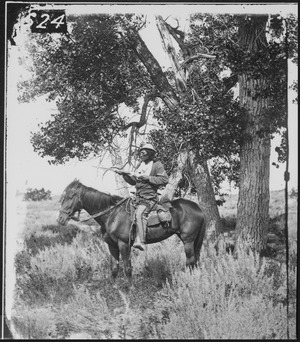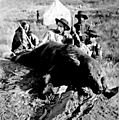Bloody Knife facts for kids
Quick facts for kids
Bloody Knife
|
|
|---|---|

Bloody Knife
|
|
| Born | ca. 1840 Dakota Territory |
| Died | 25 June 1876 (aged 35–36) Montana Territory |
| Buried |
Old Scouts Cemetery, White Shield, North Dakota
|
| Allegiance | |
| Service/ |
|
| Years of service | 1868–76 |
| Rank | Scout |
| Unit | 7th U.S. Cavalry |
| Battles/wars | American Indian Wars |
Bloody Knife (in Sioux: Tȟamila Wewe; in Arikara: NeesiRAhpát; born around 1840 – died June 25, 1876) was a brave Native American scout. He worked for the U.S. 7th Cavalry Regiment. He was the favorite scout of Lieutenant Colonel George Armstrong Custer. Many people called him "perhaps the most famous Native American scout to serve the U.S. Army."
Bloody Knife was born around 1840 in Dakota Territory. His father was a Hunkpapa Sioux, and his mother was Arikara. He was often treated unfairly by the Sioux in his village. This was because of his mother's background. A Sioux named Gall was especially mean to him. When Bloody Knife was a teenager, he left his village. He went to live with his mother's Arikara tribe. In 1862, Gall led a Sioux raid that killed Bloody Knife's brothers.
Bloody Knife worked as a courier (a messenger) and a hunter. He worked for the American Fur Company. Later, he became a scout for the U.S. Army. He served under Alfred Sully and then with George Custer. Bloody Knife died on June 25, 1876. He was killed by a bullet during the Battle of the Little Bighorn.
Contents
Early Life and Challenges
Bloody Knife was likely born between 1837 and 1840. His exact birthplace is not known. He lived in Dakota Territory. His father was a Hunkpapa Sioux. His mother was from the Arikara tribe. He lived with his father's tribe as a young child. But he was not treated well. This was because the Sioux disliked his mother's people.
Bloody Knife grew to dislike the Sioux. He especially disliked a Sioux named Gall. Gall was the adopted brother of Sitting Bull. While Sitting Bull also treated Bloody Knife badly, Gall was his biggest enemy. In 1856, Bloody Knife's mother left his father. She returned to her own tribe. Bloody Knife, who was about 15, went with her. They settled near Fort Clark. This was a trading post on the Upper Missouri River.
Conflicts between the Arikaras and Sioux happened often. Sioux war parties would attack Arikaras who went too far from the fort. Even with this danger, Bloody Knife took on a risky job. He delivered mail to other forts. These included forts in Missouri and Fort Totten. He faced many dangers during these years. Once, while visiting his father, Gall and other Hunkpapas attacked him. They beat him badly and mocked him. In 1862, Gall led a Sioux war party. They killed two of Bloody Knife's brothers.
Becoming a Scout
After working for the American Fur Company, Bloody Knife joined the army. In 1865, he became a scout for Brigadier General Alfred Sully. This was during Sully's expedition against the Sioux. Bloody Knife was very helpful to the soldiers. These soldiers were called "Galvanized Yankees." They were former Confederate prisoners who joined the Union army. He also worked as a messenger. This helped troops communicate in Sioux-controlled areas.
In late 1865, Bloody Knife met Captain Adams Bassett. Bloody Knife told Bassett that Gall was nearby and causing trouble. Bassett sent soldiers with Bloody Knife to capture Gall. Bloody Knife led them to Gall's village. The soldiers tried to arrest Gall. Gall tried to escape and was wounded. Some stories say Bloody Knife tried to shoot Gall. But an officer stopped him, saying Gall was already dead. Bloody Knife was very angry. Gall survived and later became a Sioux war chief. However, this story might not be completely true.
In 1866, President Andrew Johnson allowed the army to form Indian scout groups. Bloody Knife joined as a corporal in May 1868. He was stationed at Fort Stevenson. He left in September 1868. By 1872, he was a lance corporal. He took part in the Yellowstone Expedition that year.
Working with Custer
In 1873, Bloody Knife met George Armstrong Custer at Fort Rice. They became good friends. Custer greatly admired Bloody Knife's scouting skills. Bloody Knife was known for being very honest, even if it meant being rude. Custer found this amusing. Custer himself could be hot-tempered. Once, in 1874, Custer even shot near Bloody Knife during a fit of anger.
Custer often gave Bloody Knife gifts. One gift was a silver medal with Bloody Knife's name on it. Custer ordered it from Washington. Bloody Knife quickly became Custer's favorite scout. On the next Yellowstone Expedition, Bloody Knife joined Custer. They fought against the Sioux. Bloody Knife helped find an empty Sioux village. He guessed it had held 1,000 warriors. The group followed the trail. This led them to a battle at Yellowstone.
The Black Hills Expedition
In 1874, Bloody Knife joined the Black Hills Expedition. This large group included over a thousand men. There were geologists, soldiers, miners, reporters, and 65 Arikara scouts. Just before the expedition, the Sioux attacked the Arikara village. This happened at Fort Berthold. Five Arikaras and one Mandan were killed. One of Bloody Knife's sons died in this attack. Bloody Knife blamed Gall for his son's death.
Many Arikara scouts on the expedition wanted revenge. When they found signs of Sioux in the Black Hills, they prepared for battle. They sang war songs and painted their horses. But Custer did not want to get involved in tribal fights. He told the scouts not to attack unless they were attacked first. Bloody Knife and 25 other Arikaras went scouting. They found a small camp of five lodges. The scouts waited for Custer and his interpreter, Louis Agard.
Some reports said thousands of warriors were ready to attack. Most of the expedition thought a fight was coming. But Bloody Knife found only 27 Oglala Sioux. They had been cutting wood and hunting. They planned to return to the Red Cloud Agency. They did not know soldiers were in the area. All but one Oglala ran away when Agard and the scouts approached.
During the expedition, some wagons got stuck. Custer asked whose fault it was. A scout named Charley Reynolds blamed Bloody Knife. Custer got angry and fired his revolver near them. Bloody Knife and Reynolds hid behind trees. Bloody Knife then told Custer, "You did a bad thing to me. If I had been crazy too, you would not see another day." Custer replied, "My brother, I was angry for a moment, but it is gone now. Let us shake hands and be friends again." Bloody Knife agreed and shook Custer's hand.
Most Indian scouts earned $13 a month. This was the same as regular soldiers. But Custer arranged a special job for Bloody Knife. He worked as a guide for the quartermaster. He earned $75 a month. This was about $1,900 in today's money. On November 30, 1874, Bloody Knife left the service. He also received an extra $150 for his "invaluable assistance" during the Black Hills Expedition.
Death at Little Bighorn
In 1876, Bloody Knife was part of the Little Bighorn campaign. He tried to warn Custer many times. He said there were too many Native Americans to fight. But Custer did not listen. Even with the huge danger, Bloody Knife refused to stay out of the battle. Some stories say that before the battle, Bloody Knife made a sign to the sun. He said, "I shall not see you go down behind the hills tonight."
Bloody Knife was assigned to Major Marcus Reno. Reno had 140 soldiers under his command. This was at the Battle of the Little Bighorn on June 25, 1876. Custer told Bloody Knife and other scouts to drive away the Native American horses. As Reno's soldiers and scouts neared the camp, the Native Americans saw them. They were mostly Lakota-Sioux and Cheyenne. They quickly got ready to attack Reno.
The soldiers got off their horses. They formed a line to shoot at the enemy. But the Native Americans kept coming. Reno's unit started losing many soldiers. Bloody Knife was standing next to Reno. Reno asked Bloody Knife what the Native Americans would do. Bloody Knife was shot and killed on his horse before he could answer. Reno panicked and ordered his men to retreat. Reno and his men ran into a nearby forest. The warriors chased them. Reno's poor decision cost many soldiers their lives. Bloody Knife was one of three Arikara scouts killed that day. The others were Little Brave and Bobtail Bull. The U.S. Army suffered a huge defeat.
Bloody Knife was killed by the Sioux. He was buried in the scout cemetery. This cemetery is near White Shield, North Dakota.
Legacy
Bloody Knife married an Arikara woman named Young Owl Woman in 1866. They had at least three children. They had a daughter and two sons. The daughter died of an illness in 1870. She was buried at Fort Buford. One son was killed by Lakota in a raid. This happened before the Black Hills Expedition of 1874. The other son lived until 1904. He was reportedly killed by his own wife.
Young Owl Woman was Bloody Knife's legal heir. On April 14, 1879, she went to Fort Berthold. She claimed the money Bloody Knife was still owed for his army service. In 1881, she received his final $91.66 from the U.S. Government.
Bloody Knife's brave actions were remembered. The Arikara scouts composed a song about him after his death. His story became well-known. He became one of the most famous scouts linked to the army. In the 1991 TV mini-series Son of the Morning Star, an actor named Sheldon Peters Wolfchild played Bloody Knife.
Images for kids



